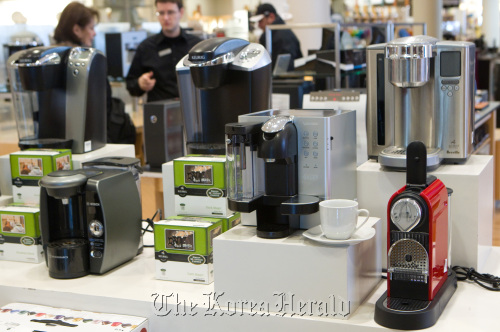CHICAGO ― Blame it on Starbucks. Consumers seem to be looking for ways to personalize everything they buy. It’s not just picking apps for their phones, special touches for their shoes or music for their iPods, but down to customizing everything from mashed potatoes to the water they drink.
Alexander Chernev, an associate professor of marketing at Northwestern’s Kellogg School of Management, said consumers derive “additional utility or value” in doing something themselves. Chernev, who studies consumer behavior, calls it “the Ikea effect” because buyers got to assemble their own furniture.
Manufacturers traditionally developed products based on consumer tastes, Chernev said. But as preferences became highly fragmented, companies decided that the only answer was to outsource the customization to consumers themselves.
For example, Heinz scored a smash hit in 2008 with a line of frozen potatoes that moms could steam in the microwave. The associated insight was this: No one likes to peel, everyone wants to mash, and moms feel better about putting something on the table when it has a personal touch. Heinz offers suggestions on the package, and more suggestions online, for “making it your own.”
It’s hardly a new trend. Apple with its iPods and computers, Harley-Davidson with its motorcycles, Nike with its NikeID shoes that allow customers to personalize their choices online, as well as Starbucks and Coca-Cola have been particularly adept at creating products that let consumers alter them to their own tastes.
The concept has accelerated for 15 years or so and seems to be gaining momentum, notably in beverages.
In February, Kraft, the Northfield, Illinois-based food giant, introduced its first new brand since the DiGiorno pizza line in 1995: MiO, a squeeze bottle of flavoring and a dropper priced at $3.99 that allows consumers to doctor their water to taste with such flavors as strawberry-watermelon and pomegranate.
“Consumers are really looking to have their personal tastes reflect in all things they’re doing and using,” said MiO senior brand manager Liza Laibe. It’s particularly important for millennials, which Kraft pegs as those age 18 to 39.
Kraft is expected to back MiO with the full force of its marketing muscle. Laibe declined to say how much would be spent but said television ads will begin airing in late March. Kraft will also give away 100,000 samples through MiO’s Facebook page.
A recent Coca-Cola innovation is the Freestyle machine that lets customers make more than 100 different beverages by adding flavors like lemon, orange or raspberry to their Diet Coke or Dasani water.
Experts trace the drink phenomenon to Starbucks, which pioneered modifiers like “no-whip,” “double shot” and “nonfat” to the masses in the early 1990s, effectively removing the stigma attached to complicated orders.
As a result of Starbucks’ success, customization became the rage. Burger King returned to popularity in 2006 in part by reminding patrons to “Have it your way.”
Sometimes, marketers may take the trend too far. Chernev pointed to a recent ad that encourages consumers to express themselves via their choice of flavored coffee creamer.
 |
Bring the taste of the coffee shop home with these single-server coffee makers. Manufacturers are looking at ways of allowing users to customize everything from coffee to flavored water. (Chicago Tribune/MCT) |
While the proliferation of choices may seem extreme, companies seem to be responding to the demands of her generation, said Sophie Grimm, a 23-year-old student at Roosevelt University’s Chicago College of Performing Arts.
“Our generation has this sense of entitlement,” she said. “It’s not only ‘the customer is always right,’ but ‘I’m always right.’”
Sometimes turning over too much choice to the consumer can backfire.
That’s one of the problems with MySpace, said 24-year-old Jered Montgomery of Chicago. The social networking site, he said, gave users too much control over the way their pages look.
Facebook, in contrast, boxes information in one basic template while also giving users just the right amount of autonomy to customize their pages, said Montgomery. “I can pick my favorite books (on Facebook), but it’s not free-range.”
Lynn Dornblaser, director of consumer packaged goods insight at Mintel International, says the media has been dramatically altered as a result of customization.
“We call it a ‘snack society’ because everybody snacks on little bits of things, little bits of data, little bits of information, and it’s all customized just to you,” Dornblaser said. She said Google Alerts and RSS feeds have capitalized on the desire for those snacks of news and information as traditional mass-audience newspapers have declined in circulation.
Now a version of what Starbucks did for store sales of coffee is expected to transform the consumption of coffee at home. The latest twist is single-serve coffee pods brewed in machines that allow people to make whatever flavor they want in less than a minute.
“Today when you drink a coffee, you’re not looking for a coffee, you’re looking for your coffee, the coffee you like, the taste you like,” said Xavier Unkovic, general manager of Mars Drinks North America, which is one of several companies betting on the trend.
Mars, which bought Milwaukee-based Alterra Coffee Roasters last year, is launching a set of Alterra packets for its Flavia machines. The coffee products, designed to boost the overall quality of Flavia’s offerings, are coupled with a number of tea products and sweet drinks, which taste like Dove chocolate or Milky Way candy bars.
Unkovic compared Americans’ increasing affinity for coffee to the growing enthusiasm for wine. “Look at wine 15 years ago,” he said, noting most stores didn’t have much of a selection. “Look at how many wines there are today. Coffee is developing in the same way.”
By Emily Bryson York and Alejandra Cancino
(Chicago Tribune)
(McClatchy-Tribune Information Services)








![[Today’s K-pop] Blackpink’s Jennie, Lisa invited to Coachella as solo acts](http://res.heraldm.com/phpwas/restmb_idxmake.php?idx=644&simg=/content/image/2024/11/21/20241121050099_0.jpg)